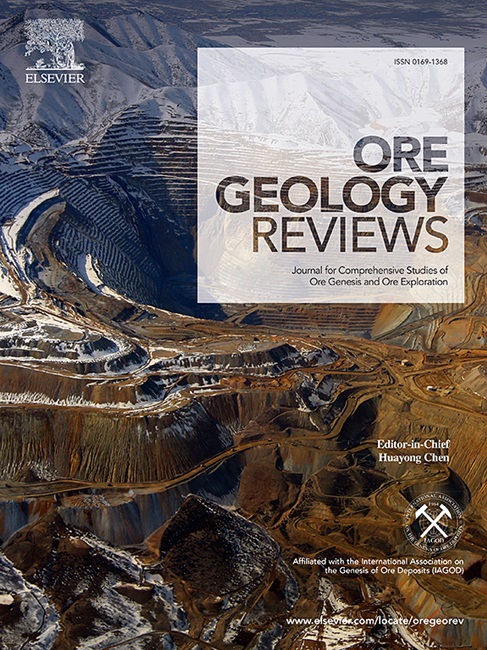W-Mo斑岩系统中矿石分布的岩性控制:以斯洛伐克喀尔巴阡山脉西部Ochtiná-Rochovce矿床为例
IF 3.6
2区 地球科学
Q1 GEOLOGY
引用次数: 0
摘要
在W-Mo斑岩矿床中,由于热液作用和流-岩反应过程中W-Mo的解耦作用,钨钼矿体往往在空间上分离。Ochtiná-Rochovce钨钼矿床的寄主岩性多变,受热液蚀变的影响,寄主多位于清晰的脉状边缘。通过地球化学和矿物学分析方法对最近一次勘探活动中获得的样品进行了详细的研究Ochtiná-Rochovce钨钼矿床。矿床上部生物千层岩和基性变质火山岩为主要的W寄主,白钨矿丰富,少量黑钨矿伴生。深层变质岩富集辉钼矿。矿化以石英网和矿脉为主,发育于黑云母-黑钨矿、白钨矿-辉钼矿-黄铁矿和钾长石-方解石阶段。在岩壁反应和早期流体减压时CO2损失的辅助下,pH值的增加使钨矿物析出。变质火山脉状边缘的黑云母取代角闪洞和斜长石,为W矿物的沉淀提供了Fe、Ca和Mg。所有岩石中黑云母的Mg/(Mg + Fe)、F含量均呈上升趋势,Ti含量呈下降趋势,表明其热液成因。富镁黑钨矿优先赋存于变质火山岩中,在与黑云母蚀变有关的早期流体中具有较高的镁含量。与减压相关的后期流体冷却,加上fO2的降低和pH的升高,促进了辉钼矿的沉积,形成石英-绢云母±黄铁矿边缘。白钨矿的沉淀和黑钨矿的替代与黑云母结晶后aFe/aCa的逐渐降低有关,伴随着与辉钼矿饱和度相关的fS2的增加。随着流体-岩石反应和冷却的进行,酸性和fO2进一步下降,S(−II)富集,Fe(II)释放到流体中,从而生成丰富的黄铁矿。所提出的模型将岩性的性质与矿石沉淀过程联系起来,有助于在全球范围内更有效地勘探这类矿化。本文章由计算机程序翻译,如有差异,请以英文原文为准。

Lithological control on the distribution of ores in W-Mo porphyry systems: An example from the Ochtiná-Rochovce deposit (Western Carpathians, Slovakia)
In W-Mo porphyry deposits, tungsten and molybdenum ore bodies are often spatially separated due to the decoupling of W and Mo during hydrothermal processes and fluid-rock reactions. The Ochtiná-Rochovce W-Mo deposit has variable host lithologies affected by hydrothermal alteration mostly in well-defined vein selvedges. The Ochtiná-Rochovce W-Mo deposit was studied in detail by geochemical and mineralogical analytical methods on samples derived from a recent exploration campaign. Biotitic phyllite and mafic metavolcanites in upper parts of the deposit are the main W host, with abundant scheelite, accompanied by minor wolframite. Deeper metasandstone is enriched in molybdenite. Mineralisation is hosted by quartz stockworks and veins, and developed during biotite-wolframite, scheelite-molybdenite-pyrite and K-feldspar-calcite stages. Tungsten minerals precipitated by an increase in pH aided by wall-rock reactions and loss of CO2 from early fluids on decompression. Amphibole and plagioclase replacement by biotite in vein selvedges in metavolcanites provided Fe, Ca, and Mg for precipitation of W minerals. The trend of increasing Mg/(Mg + Fe), F and decreasing Ti in biotite in all rocks suggest its hydrothermal origin. The Mg-rich wolframite preferentially occurring in metavolcanites documents a high aMg in the early fluids related to biotite alteration. Molybdenite deposition was promoted by cooling of later fluids, related to decompression, combined with decreasing fO2 and increase in pH, resulting in quartz-sericite ± pyrite selvedges. Scheelite precipitation and replacement of wolframite are related to a progressive decrease in aFe/aCa following the biotite crystallisation, accompanied by increase in fS2 associated with the saturation with respect to molybdenite. Progress of fluid-rock reactions and cooling invoked a further drop of acidity and fO2, enrichment in S(−II), and liberation of Fe(II) into the fluid, thereby generating abundant pyrite. The presented model, that links the nature of lithologies to ore precipitation processes, can aid in a more efficient exploration for this type of mineralisation worldwide.
求助全文
通过发布文献求助,成功后即可免费获取论文全文。
去求助
来源期刊

Ore Geology Reviews
地学-地质学
CiteScore
6.50
自引率
27.30%
发文量
546
审稿时长
22.9 weeks
期刊介绍:
Ore Geology Reviews aims to familiarize all earth scientists with recent advances in a number of interconnected disciplines related to the study of, and search for, ore deposits. The reviews range from brief to longer contributions, but the journal preferentially publishes manuscripts that fill the niche between the commonly shorter journal articles and the comprehensive book coverages, and thus has a special appeal to many authors and readers.
 求助内容:
求助内容: 应助结果提醒方式:
应助结果提醒方式:


